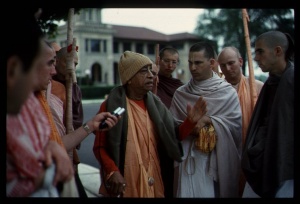CC Adi 10.120 (1975): Difference between revisions
(Vanibot #0027: CCMirror - Mirror CC's 1996 edition to form a basis for 1975) |
(Vanibot #0020: VersionCompareLinker - added a link to the Version Compare feature) |
||
| Line 2: | Line 2: | ||
<div style="float:left">'''[[Sri Caitanya-caritamrta (1975)|Śrī Caitanya-caritāmṛta (1975)]] - [[CC Adi (1975)|Ādi-līlā]] - [[CC Adi 10 (1975)|Chapter 10: The Trunk, Branches and Subbranches of the Caitanya Tree]]'''</div> | <div style="float:left">'''[[Sri Caitanya-caritamrta (1975)|Śrī Caitanya-caritāmṛta (1975)]] - [[CC Adi (1975)|Ādi-līlā]] - [[CC Adi 10 (1975)|Chapter 10: The Trunk, Branches and Subbranches of the Caitanya Tree]]'''</div> | ||
<div style="float:right">[[File:Go-previous.png|link=CC Adi 10.119 (1975)|Ādi-līlā 10.119]] '''[[CC Adi 10.119 (1975)|Ādi-līlā 10.119]] - [[CC Adi 10.121 (1975)|Ādi-līlā 10.121]]''' [[File:Go-next.png|link=CC Adi 10.121 (1975)|Ādi-līlā 10.121]]</div> | <div style="float:right">[[File:Go-previous.png|link=CC Adi 10.119 (1975)|Ādi-līlā 10.119]] '''[[CC Adi 10.119 (1975)|Ādi-līlā 10.119]] - [[CC Adi 10.121 (1975)|Ādi-līlā 10.121]]''' [[File:Go-next.png|link=CC Adi 10.121 (1975)|Ādi-līlā 10.121]]</div> | ||
{{CompareVersions|CC|Adi 10.120|CC 1975|CC 1996}} | |||
{{RandomImage}} | {{RandomImage}} | ||
==== TEXT 120 ==== | ==== TEXT 120 ==== | ||
| Line 11: | Line 10: | ||
<div class="verse"> | <div class="verse"> | ||
:mahā-kṛpā-pātra prabhura jagāi, mādhāi | :mahā-kṛpā-pātra prabhura jagāi, mādhāi | ||
: | :'patita-pāvana' nāmera sākṣī dui bhāi | ||
</div> | </div> | ||
| Line 25: | Line 24: | ||
<div class="translation"> | <div class="translation"> | ||
Jagāi and Mādhāi, the eighty-ninth and ninetieth branches of the tree, were the greatest recipients of Lord | Jagāi and Mādhāi, the eighty-ninth and ninetieth branches of the tree, were the greatest recipients of Lord Caitanya's mercy. These two brothers were the witnesses who proved that Lord Caitanya was rightly named Patita-pāvana, "the deliverer of the fallen souls." | ||
</div> | </div> | ||
| Line 32: | Line 31: | ||
<div class="purport"> | <div class="purport"> | ||
In the Gaura-gaṇoddeśa-dīpikā (115) it is said that the two brothers Jagāi and Mādhāi were formerly the doorkeepers named Jaya and Vijaya, who later became Hiraṇyākṣa and Hiraṇyakaśipu. Jagāi and Mādhāi were born in respectable brāhmaṇa families, but they adopted the professions of thieves and rogues and thus became implicated in all kinds of undesirable activities, especially woman-hunting, intoxication and gambling. Later, by the grace of Lord Caitanya Mahāprabhu and Śrī Nityānanda Prabhu, they were initiated, and they got the chance to chant the Hare Kṛṣṇa mahā-mantra. As a result of chanting, both brothers became exalted devotees of Lord Caitanya Mahāprabhu. The descendants of Mādhāi still exist, and they are respectable brāhmaṇas. The tombs of these two brothers, Jagāi and Mādhāi, are in a place known as Ghoṣahāṭa, or Mādhāitalā-grāma, which is situated about one mile south of Katwa. It is said that Śrī Gopīcaraṇa dāsa Bābājī established a temple of Nitāi-Gaura at this place about two hundred | In the Gaura-gaṇoddeśa-dīpikā (115) it is said that the two brothers Jagāi and Mādhāi were formerly the doorkeepers named Jaya and Vijaya, who later became Hiraṇyākṣa and Hiraṇyakaśipu. Jagāi and Mādhāi were born in respectable brāhmaṇa families, but they adopted the professions of thieves and rogues and thus became implicated in all kinds of undesirable activities, especially woman-hunting, intoxication and gambling. Later, by the grace of Lord Caitanya Mahāprabhu and Śrī Nityānanda Prabhu, they were initiated, and they got the chance to chant the Hare Kṛṣṇa mahā-mantra. As a result of chanting, both brothers became exalted devotees of Lord Caitanya Mahāprabhu. The descendants of Mādhāi still exist, and they are respectable brāhmaṇas. The tombs of these two brothers, Jagāi and Mādhāi, are in a place known as Ghoṣahāṭa, or Mādhāitalā-grāma, which is situated about one mile south of Katwa. It is said that Śrī Gopīcaraṇa dāsa Bābājī established a temple of Nitāi-Gaura at this place about two hundred years ago. | ||
</div> | </div> | ||
Latest revision as of 14:06, 26 January 2020

A.C. Bhaktivedanta Swami Prabhupada
TEXT 120
- mahā-kṛpā-pātra prabhura jagāi, mādhāi
- 'patita-pāvana' nāmera sākṣī dui bhāi
SYNONYMS
mahā-kṛpā-pātra—object of very great mercy; prabhura—of the Lord; jagāi mādhāi—the two brothers Jagāi and Mādhāi; patita-pāvana—deliverer of the fallen; nāmera—of this name; sākṣī—witness; dui bhāi—these two brothers.
TRANSLATION
Jagāi and Mādhāi, the eighty-ninth and ninetieth branches of the tree, were the greatest recipients of Lord Caitanya's mercy. These two brothers were the witnesses who proved that Lord Caitanya was rightly named Patita-pāvana, "the deliverer of the fallen souls."
PURPORT
In the Gaura-gaṇoddeśa-dīpikā (115) it is said that the two brothers Jagāi and Mādhāi were formerly the doorkeepers named Jaya and Vijaya, who later became Hiraṇyākṣa and Hiraṇyakaśipu. Jagāi and Mādhāi were born in respectable brāhmaṇa families, but they adopted the professions of thieves and rogues and thus became implicated in all kinds of undesirable activities, especially woman-hunting, intoxication and gambling. Later, by the grace of Lord Caitanya Mahāprabhu and Śrī Nityānanda Prabhu, they were initiated, and they got the chance to chant the Hare Kṛṣṇa mahā-mantra. As a result of chanting, both brothers became exalted devotees of Lord Caitanya Mahāprabhu. The descendants of Mādhāi still exist, and they are respectable brāhmaṇas. The tombs of these two brothers, Jagāi and Mādhāi, are in a place known as Ghoṣahāṭa, or Mādhāitalā-grāma, which is situated about one mile south of Katwa. It is said that Śrī Gopīcaraṇa dāsa Bābājī established a temple of Nitāi-Gaura at this place about two hundred years ago.